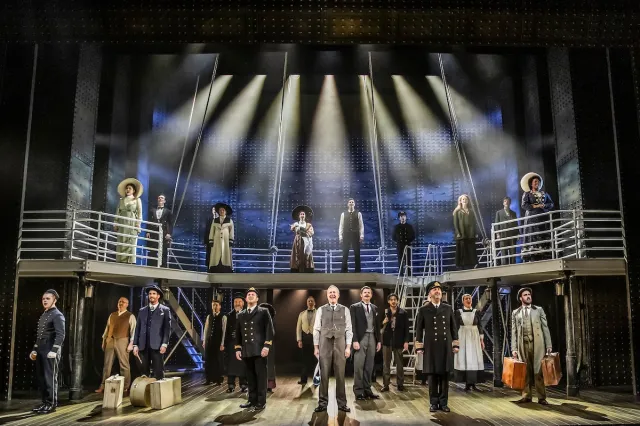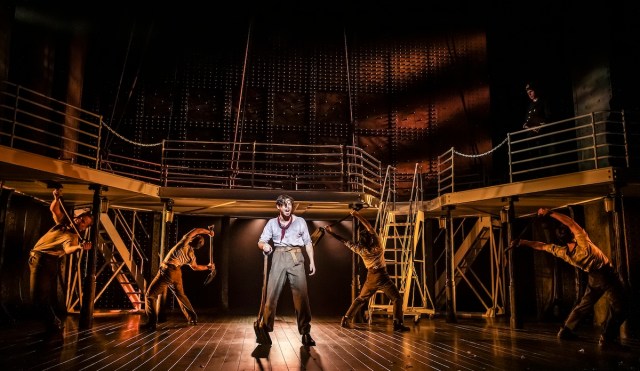Review: Titanic the Musical Sails to a Movie Theater Near You
The long-running UK production receives a first-class film capture.

(© Pamela Raith)
Titanic the Musical sounds like a punchline you might encounter in an episode of The Simpsons or South Park — a sight gag about the manifest destiny of musical theater, in which even the world’s most famous maritime disaster is not safe from schmaltzy ballads and shrieking sopranos. But those old enough to remember watching The Rosie O’Donnell Show will recall that there really was a 1997 Broadway musical called Titanic, and it ran for 804 performances at the Lunt-Fontanne Theatre, buoyed by the support of Broadway’s premier booster and a worldwide craze for all things Titanic brought about by the subsequent release of the James Cameron film.
The Broadway production closed in 1999, but Titanic lives on in the UK, where love never dies for the mega-musicals that were ubiquitous in the ’80s and ’90s. A slimmed-down production of Titanic by director Thom Southerland was first seen in 2013 at London’s Southwark Playhouse and has regularly played the West End since, recently completing its 10th anniversary tour. Musical theater lovers and the morbidly curious can now see a filmed version, which is set to show in 700 movie theaters nationwide on November 4 and 8.
It’s not the story of Jack and Rose (for a hilarious version of that, I recommend Titaníque off-Broadway). Book writer Peter Stone hews much closer to the model of Walter Lord’s A Night to Remember, with an intricate narrative introducing us to the real people onboard the Titanic when it sunk into the North Atlantic on April 15, 1912: There’s Captain Edward Smith (a stately Graham Bickley), shipbuilder Thomas Andrews (Ian McLarnon), and White Star Line Chairman J. Bruce Ismay (Martin Allanson, oil practically dripping from his pointed capitalist mustache). They are the reigning triumvirate of this floating city, whose temporary residents include Vanderbilts, Astors, and Guggenheims. We feel for the poor radio operator (Alastair Hill) while his bosses hurl accusations over his shoulder as he desperately signals for help.
Stone also concocts fictional characters like Alice Beane (the exasperatingly funny Bree Smith), a second-class passenger who longs to hobnob with the upper crust (she’s this show’s Hyacinth Bucket). There’s also steerage passenger Kate McGowan (Lucie-Mae Sumner), who is fleeing Ireland, single and pregnant, for a fresh start in America. She sees a potential partner in fellow passenger Jim Farrell (Chris Nevin). They each float along on their dreams until an iceberg rudely punctures their serenity.

(© Pamela Raith)
With big puppy-dog eyes and a pristine tenor voice, Adam Filipe is magnificent as Barrett, a stoker toiling in the bowels of the ship who telegraphs a marriage proposal as his final communication. His performance is the most recognizably human.
But tears are most reliably won by Valda Aviks and David Delve as Ida and Isidor Straus, the wealthy older couple who opt to go down with the ship rather than separate. Aviks and Delve have the chemistry of an old married couple who still very much enjoy each other’s company, and their song “Still” is the emotional highlight of the show.
Sometimes overshadowed by the question of taste (over 1,500 real people perished on the Titanic) is the undeniable fact that composer Maury Yeston has written a lovely score, stuffed with overlapping motifs and complex harmonies. While the lyrics are sometimes cringeworthy (Yeston shows his research in the opening number when a cabin boy sings about the lettuce headcount), he compensates with melodies that you’ll be humming all the way home. It sounds gorgeous under the music direction of Ben Papworth, with perfect sound balance by designer Andrew Johnson, who also provides the lurches and groans than prompt much of the action in the second act, when mild annoyance slowly darkens to abject terror.
Southerland’s production tells this story with fewer expensive moving parts than the original production, employing a fluidity in staging that keeps the show steaming ahead. While sparing no expense on the beautiful period costumes, designer David Woodhead creates the deck of the Titanic using scaffolding and a moving staircase. A clever pulley system allows the upper deck to tilt during the final moments. Howard Hudson’s lighting affects a dreamlike atmosphere, in which the ghosts of the past return to tell their stories. That all disappears in a harshly lit final scene, in which the actors look at a printed list of the dead and offer parting remarks in what feels uncomfortably close to undergraduate agitprop.
Yeston and Stone are most interested in the hubris of progress, how humanity’s reach for Godlike technology is so often met with disaster. That’s a story Aeschylus could get behind, and it has perennial relevance in the age of AI as we contemplate the return of supersonic passenger travel.
Yet while technology progresses, the theater seems to balk at any title without major brand recognition. Titanic is the kind of show Gutenberg! The Musical! tries to send up, largely failing to do so because so few of these epic historical musicals are produced anymore (Paradise Square is the last real example on Broadway). As campy as they are, I cannot help feeling that Broadway is a poorer place without them, overrun with musical adaptations of successful movies that, if at all profitable, will inevitably become movie-musicals. This film capture of Titanic is less about remembering the ship of dreams as it is about remembering a time when Broadway producers knew how to dream big.











